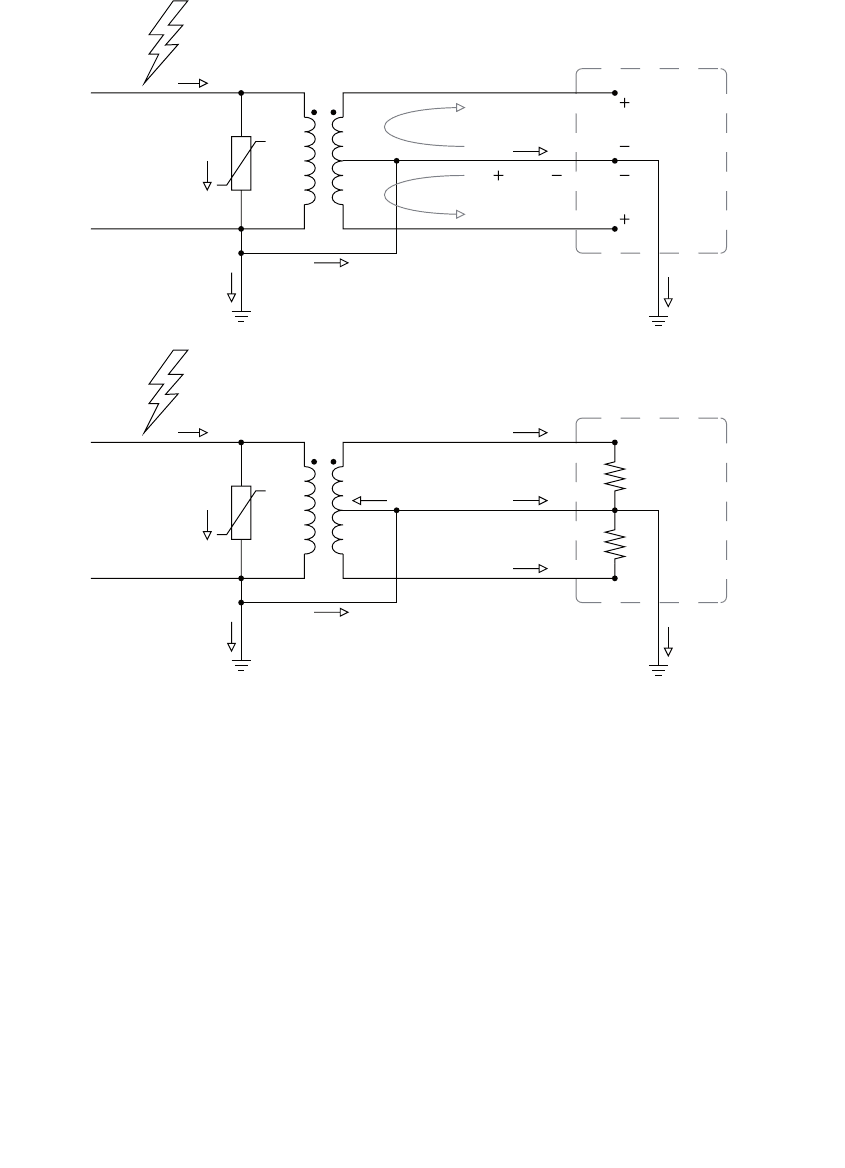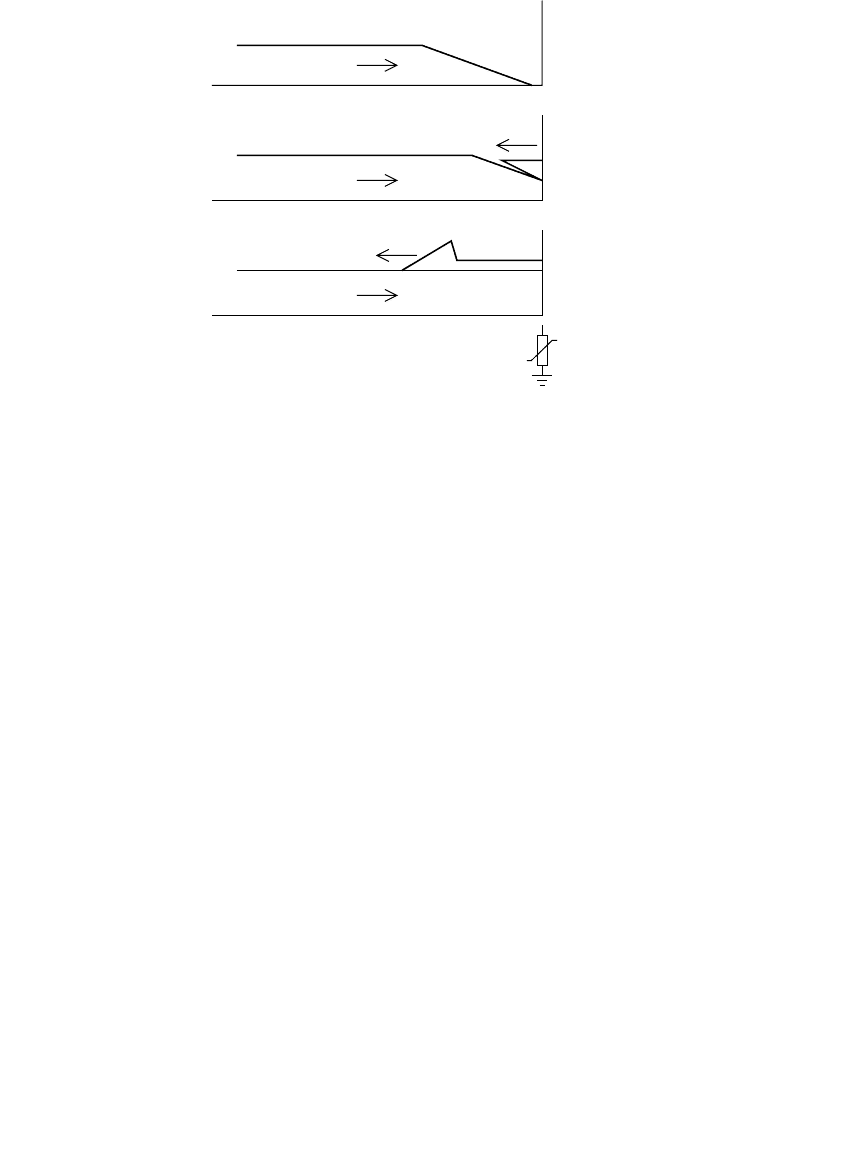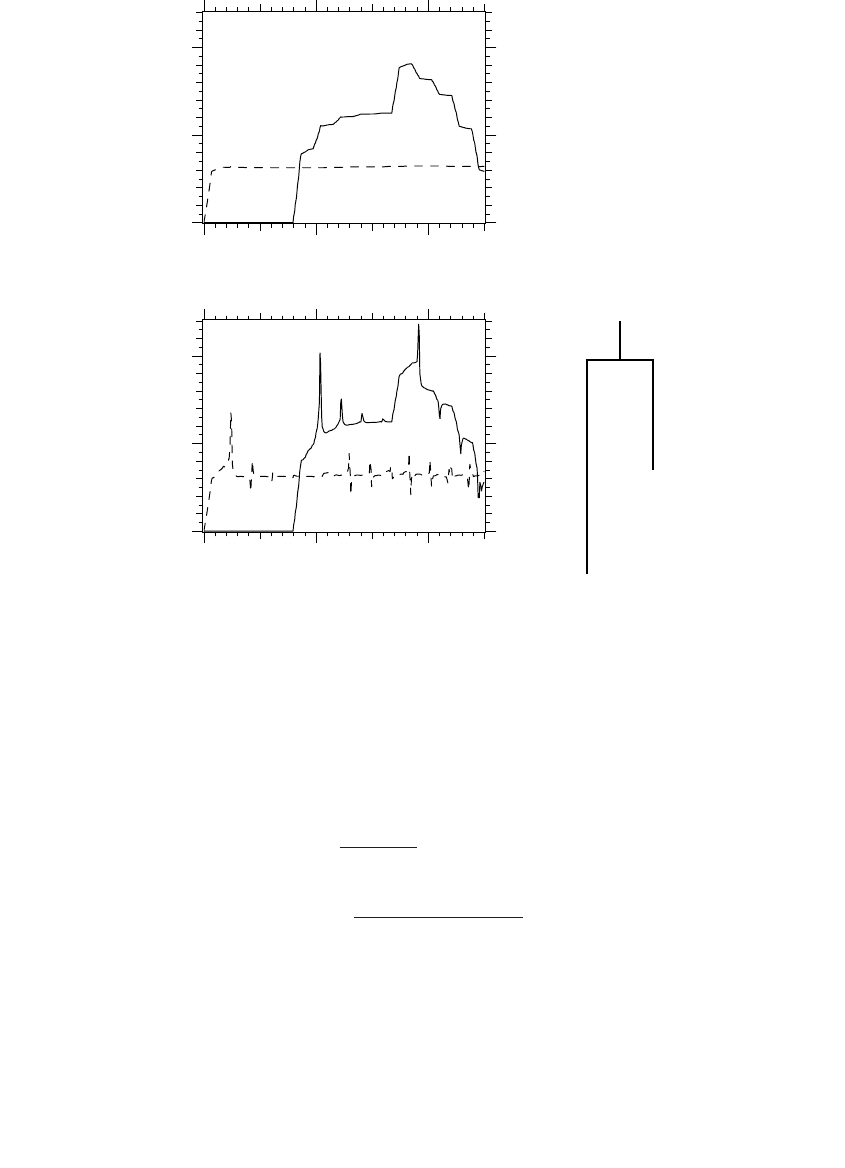Short T.A. Electric Power Distribution Handbook
Подождите немного. Документ загружается.


618 Electric Power Distribution Handbook
2. Tie the ground lead to the tank — The NESC (IEEE C2-1997) requires
arrester ground leads to be tied to an appropriate ground. To achieve
any protection, the ground lead must be tied to the tank of the equip-
ment being protected. Without attaching the ground lead to the tank,
the transformer or other equipment is left completely unprotected.
Arrester vs. fuse placement is an ongoing industry debate. Tank mounting
an arrester protects the transformer best; but since the transformer is down-
stream of the fuse, the lightning surge current passes through the fuse.
Lightning may blow the fuse unnecessarily, and many utilities have histories
of nuisance fuse operations. Applying the arrester upstream of the fuse keeps
the surge current out of the fuse, but usually results in long lead lengths. I
prefer the tank mounted approach along with using larger fuses or surge
resistant fuses to limit unnecessary fuse operations.
12.5.3 Secondary-Side Transformer Failures
Single-phase residential-type transformers (three-wire 120/240-V service)
may also fail from surge entry into the low-voltage winding. This damage
mode has been extensively discussed within the industry (sparking com-
peting papers from manufacturers) and summarized by an IEEE Task Force
(1992). Lightning current into the neutral winding of the transformer (usu-
ally X2) induces possibly damaging stresses in the high-voltage winding
near the ground and line ends, both turn-to-turn and layer-to-layer. Light-
ning current can enter X2 from strikes to the secondary or strikes to the
primary (where it gets to the neutral through a surge arrester or flashover,
see Figure 12.18).
The most concern with secondary surge entry is on small (< 50 kVA)
overhead transformers with a noninterlaced secondary winding (pad-
FIGURE 12.17
Lead length.
Surge current path
Insulation Arrester
Line side lead length
Ground side lead length
1791_book.fm Page 618 Monday, August 4, 2003 3:20 PM
(C) 2004 by CRC Press LLC

Lightning Protection 619
mounted transformers are also vulnerable). The primary arrester does not
limit the voltage stresses on the ends of the primary winding. Currents
couple less to the high-voltage winding on transformers with an interlaced
secondary winding, which is used on core-type transformers and some shell-
type transformers. Smaller kVA transformers are most prone to damage from
this surge entry mode.
When the surge current gets to the transformer neutral, it has four places
to go: down the pole ground, along the primary neutral, along the secondary
neutral towards houses, or into the transformer winding. Current through
the secondary neutral creates a voltage drop along the neutral. This voltage
drop will push current through the transformer when load is connected at
the customer (Figure 12.18). The voltage created by flow through the neutral
is partially offset by the mutual inductance between the secondary neutral
FIGURE 12.18
Surge entry via the secondary.
Pole ground
Service entrance ground
Loop voltages induced
No Customer Load
Pole ground
Service entrance ground
With Load (or meter gap sparkover)
1791_book.fm Page 619 Monday, August 4, 2003 3:20 PM
(C) 2004 by CRC Press LLC

620 Electric Power Distribution Handbook
and the phases (tighter coupling is better). The major factors impacting
secondary-surge severity are:
• Interlacing — For a balanced surge (equal in both windings), the
inductance provided by the transformer is approximately the hot
leg to hot leg short-circuit reactance. Transformers with interlaced
secondaries have significantly lower inductances (see Table 12.10).
Higher transformer inductance induces a higher voltage on the pri-
mary-side winding.
• Transformer size — Smaller transformers have higher inductances,
inducing a higher voltage on the primary-side winding.
• Grounding — Better grounding on the transformer helps reduce the
current into the transformer. Poor grounding sends more current
into the transformer and more current into houses connected to the
transformer. Other nearby primary grounds help to reduce the cur-
rent into the transformer.
• Secondary wire — Since triplex has tighter coupling than open-wire
secondaries (and less voltage induced in the loop), a secondary of
triplex has less current into the transformer neutral terminal.
• Multiple secondaries — The worst case is with one secondary drop
from the transformer; several in parallel reduce the current by pro-
viding parallel paths.
• Secondary length — Longer secondaries are more prone to failure
(more voltage induced in the loop).
In normal lightning areas, this surge failure mode is normally neglected.
In high lightning areas, using interlaced transformers leads to a lower failure
rate [by a factor of three for lightning-related failures according to Goedde
et al. (1992)]. Utilities may use secondary arresters or spark gaps to reduce
the transformer failure rate on noninterlaced units. Goedde also reported
that transformer failure rates reduced to 0.05% (from their normal 0.2 to 1%)
on 25,000 transformers that they made with secondary arresters. Either a
metal-oxide secondary arrester or a secondary spark gap effectively protects
TABLE 12.10
Typical Transformer Inductances
Interlaced Transformers Noninterlaced Transformers
10 kVA Core 17.4 mH 10 kVA Shell 204 mH
10 kVA Shell 18.1 mH
15 kVA Shell 17.8 mH 15 kVA Shell 257 mH
25 kVA Shell 22.6 mH 25 kVA Shell 124 mH
Source: EPRI TR-000530, Lightning Protection Design Workstation
Seminar Notes, Electric Power Research Institute, Palo Alto, CA,
1992.
1791_book.fm Page 620 Monday, August 4, 2003 3:20 PM
(C) 2004 by CRC Press LLC

Lightning Protection 621
transformers from secondary-side failure modes. Economically, secondary-
side surge protection can make sense in higher lightning areas. An IEEE Task
Force report (1992) (based on Ward, 1990) cites that about 1% of a trans-
former’s first cost is saved for every 0.1% reduction in failure rate.
12.6 Underground Equipment Protection
Underground equipment is susceptible to lightning damage; in the normal
scenario, lightning hits an overhead line near the cable, and a surge travels
into the cable at the riser pole. The most important item that makes cable
protection difficult is:
• Voltage doubling — when a surge voltage traveling down a cable hits
an end point, the voltage wave reflects back, doubling the voltage.
Normally, for analysis of underground protection, we assume no attenu-
ation in the surge and that the voltage doubles at open points. The surge
impedance of cable is approximately 50 W, which is lower than the 400 W
overhead line surge impedance. So, if a lightning current has a choice
between the cable and an overhead line, most of it enters the cable. Normally
though, the cable has a surge arrester at the riser pole, and a conducting
surge arrester has an impedance of less than five ohms (for an arrester with
LPL = 30 kV and a 10-kA stroke, LPL/I = 30 kV/10 kA = 3 W), so the surge
arrester conducts most of the current. Surges travel more slowly on cables,
roughly one half of the speed of light. Transformers along the cable have
little effect, and a transformer termination is the same as an open circuit to
the surge.
The chopped wave withstand equals the BIL for cable (so we do not have
the extra 15% for the chopped wave protective margin). Since the BIL and
CWW are the same, we only need one protective margin equation:
where V
t
is the total voltage impressed across the insulation. With an arrester
at the riser pole and no arresters in the underground portion, we must use
twice the voltage at the riser pole, including the lead length:
so
PM
V
t
CWW
=
BIL
-
È
Î
Í
˘
˚
˙
◊1 100
V Ldi dt
t
=+2( / )FOW
1791_book.fm Page 621 Monday, August 4, 2003 3:20 PM
(C) 2004 by CRC Press LLC

622 Electric Power Distribution Handbook
Table 12.11 shows protective margins for several voltages using a riser-
pole arrester. All of the margins are unacceptable, except for the 12.47-kV
case with no lead length (the 24.9-kV case is barely acceptable per the stan-
dards). With a heavy-duty arrester (FOW = 36 kV) for the 12.47-kV case, the
protective margin drops to:
While a 20% protective margin is considered acceptable per IEEE C62.22-
1997, there are many reasons why it is prudent to design for larger margins.
First, insulation in cables and transformers can degrade with time. Second,
non-standard lightning waveshapes, 60-Hz cable charging effects, and
extreme rates of rise may increase the voltage above what we have estimated.
Ideally, a 50% margin or better is a good design objective. To have a 50%
margin with the riser-pole arrester, the lead length must be less than 4 in.
(10 cm). Figure 12.19 shows how to obtain the smallest lead length possible.
To obtain minimum lead length, be sure to jumper to the arrester first and
tie the ground lead to the cable neutral.
Table 12.11 shows that it was difficult to obtain reasonable protective
margins with just an arrester at the riser pole. In the next section, we will
discuss how to increase margins by adding an open-point arrester to prevent
voltage doubling.
12.6.1 Open Point Arrester
For grounded 15-kV class systems, an arrester just at the riser pole is suffi-
cient, but only if it is a riser-pole type arrester and only if the arrester is right
across the pothead bushing (minimal lead length). For higher-voltage appli-
cations, we need additional arresters. Putting an arrester at the end of the
cable prevents doubling. Although the voltage cannot double, reflections
that occur before the endpoint arrester starts full conduction will raise the
voltage in the middle of the cable (see Figure 12.20). To account for the
reflected portion, use:
where LPL
riser
is the 10-kA protective level of the riser-pole arrester, and
LPL
openpoint
is the 1.5-kA protective level of the open-point arrester. The lower-
PM
Ldi dt
CWW
=
BIL
FOW2
1 100
(/)+
-
È
Î
Í
˘
˚
˙
◊
PM
CWW
=
95
236
1 100 32
()
-
È
Î
Í
˘
˚
˙
◊=%
V
t
=+LPL LPL
riser openpoint
1
2
1791_book.fm Page 622 Monday, August 4, 2003 3:20 PM
(C) 2004 by CRC Press LLC

Lightning Protection 623
FIGURE 12.19
Minimum lead length on a riser pole. (From IEEE Std. 1299/C62.22.1-1996. Copyright 1997
IEEE. All rights reserved.)
TABLE 12.11
Typical Underground Protective Margins with a Riser-Pole
Arrester, No Other Arresters, and Using 8 kV/ft (26 kV/m) of
Lead Length
System
Voltage
(kV)
Arrester
MCOV
(kV)
CWW
(= BIL)
(kV)
FOW
(kV)
Ldi/dt
(kV)
V
t
(kV) PM
CWW
No Lead Length
12.47Y/7.2 8.4 95 29 0 58 64%
24.9Y/14.4 15.3 125 51 0 102 23%
34.5Y/19.9 22 150 77 0 154 -3%
3-ft (0.9-m) Lead Length
12.47Y/7.2 8.4 95 29 24 106 -10%
24.9Y/14.4 15.3 125 51 24 150 -17%
34.5Y/19.9 22 150 77 24 202 -26%
1791_book.fm Page 623 Monday, August 4, 2003 3:20 PM
(C) 2004 by CRC Press LLC

624 Electric Power Distribution Handbook
current protective level of the open-point arrester is used since the riser pole
arrester drains off most of the current leaving much less in the cable (with
a surge impedance of 50 W, a 35-kV voltage surge corresponds to 0.7 kA of
current). Note that the protective level of the open-point arrester is higher
(it is a light-duty arrester).
The portion of the wave that is reflected before the open-point arrester
starts to conduct adds to the incoming wave. Because of this, surges with
low rise times cause the most severe overvoltage (contrary to most overvolt-
age scenarios). We have neglected the riser-pole lead length for the reflected
voltage, primarily because lead length causes a short-duration voltage on
the front of a fast-rising surge. This is just the sort of surge that the open-
point arrester handles well because it immediately starts conducting.
With an open-point arrester, we still need to include the lead length in the
chopped-wave margin calculation (we just do not add any factor for a reflec-
tion from the end of the cable). Protective margins in Table 12.12 and Table
12.13 show that we have more leeway with lead length if we have an open-
point arrester.
Several options are available for arresters on cable systems. Elbow arresters
attach to padmounted transformers, switching enclosures, or other equip-
ment with 200-A loadbreak connectors (IEEE Std. 386-1995). A parking-stand
arrester attaches to the enclosure and allows the open, energized cable to be
“parked” on an arrester (with a 200-A elbow connector). A bushing arrester
fits between a cable elbow and an elbow bushing. Under-oil arresters used
in padmounted transformers are another option for protecting underground
equipment; they have good thermal performance and have cost advantages.
FIGURE 12.20
Voltage reflections with an open-point arrester.
Open point
with an
arrester
Reflected
wave
Reflected wave
Incoming wave
1791_book.fm Page 624 Monday, August 4, 2003 3:20 PM
(C) 2004 by CRC Press LLC

Lightning Protection 625
Normally, we neglect attenuation in cables. This is the conservative
approach. Owen and Clinkenbeard (1978) found that a 1/40-msec wave
injected into a cable attenuated less than 5% even at 6000 ft (1800 m).
Attenuation increases significantly with frequency. Owen and Clinkenbeard
found that a sparkover voltage wave attenuated by 40% after 6000 ft (1800
m) (the sparkover voltage is a narrow voltage spike — on a gapped arrester,
it is the portion of voltage that occurs before the gap sparks over). Most
significantly for cable protection, attenuation softens the lead length induc-
tive kick. The attenuation depends on cable type. Zou and Boggs (2002)
showed that EPR has an order of magnitude higher attenuation than TR-
XLPE, mainly because of higher dielectric losses in the cable. Their EMTP
simulations of cable voltages were significantly lower on EPR cable than on
TR-XLPE cable, especially with long lead lengths, because of the difference
in attenuation.
For cable protection, utilities are wise to have high protective margins.
Most of the history verifying distribution overvoltage protection practices
comes from arresters applied with over 50% protective margin. Effective
lightning protection helps limit high failure rates that have been experienced
in the industry (and riser poles expose a significant amount of equipment
to overvoltages). Several other factors can cause margins to be less than
they appear:
TABLE 12.12
Typical Underground Protective Margins with a Riser-Pole
Arrester and an Open Point Arrester
System
Voltage
(kV)
Arrester
MCOV
(kV)
BIL
(kV)
LPL
riser
(kV)
LPL
openpoint
(kV)
V
t
(kV) PM
BIL
12.47Y/7.2 8.4 95 27 32 43 121%
24.9Y/14.4 15.3 125 48 58 77 62%
34.5Y/19.9 22 150 72 90 117 28%
TABLE 12.13
Typical CWW Underground Protective Margins with a Riser-Pole
Arrester and an Open Point Arrester
System
Voltage
(kV)
Arrester
MCOV
(kV)
CWW
(= BIL)
(kV)
FOW
(kV)
Ldi/dt
(kV)
V
t
(kV) PM
CWW
3-ft (0.9-m) Lead Length
12.47Y/7.2 8.4 95 29 24 53 79%
24.9Y/14.4 15.3 125 51 24 75 67%
34.5Y/19.9 22 150 77 24 101 49%
1791_book.fm Page 625 Monday, August 4, 2003 3:20 PM
(C) 2004 by CRC Press LLC

626 Electric Power Distribution Handbook
• Quadrupling — Barker (1990) showed that voltages can as much as
quadruple for bipolar surges into the riser-pole arrester. While light-
ning currents are not known to have bipolarities, induced voltages
from nearby strikes can induce bipolar waveshapes.
• System voltage — The system voltage or trapped charge can add to
the voltage in the cable. If lightning hits a line at a time when the
system voltage happens to be at a peak of the opposite polarity, the
arrester will not go into complete conduction until the voltage
impulse has compensated for system voltage. On a 12.47Y/7.2-kV
system, this adds another to the traveling wave.
• Insulation deterioration — Transformer and cable insulation degrades
over time, which reduces the margin of protection provided by
arresters.
Application of arresters is both a science and an art and should be applied
based on local conditions. Higher lightning areas justify better protection
(a higher protective margin), especially if a utility has high historical cable
failure rates. As always, we must weigh the cost against the risk.
12.6.2 Scout Arresters
Another option for protecting cables is to use scout arresters, arresters applied
on the overhead line on both sides of the riser pole (Kershaw, 1971). A scout
arrester intercepts and diverts a lightning current that is heading towards
the riser pole. Since most of the current conducts through the closest arrester,
less voltage gets in the cable at the riser pole (unless lightning hits almost
right at the cable). Virginia Power has applied scout arresters to riser poles
to try to reduce high failure rates of certain types of cables at 34.5 kV (Marz
et al., 1994). Transient simulations done by Marz et al. found improved
protective margins with the scout arresters.
Scout arrester effectiveness depends on grounding the scout arresters well.
Without good grounding, the ground potential rises at the scout arrester,
causing high voltage on the phase and neutral wire (but little voltage dif-
ference between them). When the surge arrives at the riser pole, the low-
impedance ground path offered by the cable drops the neutral potential (and
increases the phase-to-neutral voltage). This pulls significant current through
the riser-pole arrester (and sends a voltage wave down the cable), which
reduces the effectiveness of the scout arresters. The lower the impedance of
the scout arrester grounds, the less this effect occurs.
12.6.3 Tapped Cables
If cables are tapped, complex reflections can cause voltage to more than
double, with voltage at an open point reaching over 2.8 times the peak
voltage at the riser pole [see Figure 12.21 and (Hu and Mashikian, 1990)].
2=(.)72 10.18 kV
1791_book.fm Page 626 Monday, August 4, 2003 3:20 PM
(C) 2004 by CRC Press LLC

Lightning Protection 627
The voltage varies depending on the lengths of each section beyond the tap
point. For tapped cables with no open point arresters, find both the BIL and
chopped protective margins and include a 2.6 multiplier in the BIL protective
margin calculation (this is not the worst case but applies some extra safety):
The lead length voltage is not doubled in the chopped-wave protective
margin since the inductive voltage spike from the lead length does not
coincide with the reflections causing the highest overvoltage. On tapped
cables, applying open point arresters to both open points provides the safest
protection. Arresters at the tap points are also an option for protection.
FIGURE 12.21
Transient simulation of traveling waves on a tapped cable (0.5-ms risetime).
No lead length
at the riser pole
tap #1
open point
0 2 4
0
50
100
2-ft (0.6-m)
lead length
0 2 4
0
50
100
Time, µs
Voltage, kV
Time, µs
Voltage, kV
Riser pole
tap #2
tap #1
800 ft
(245 m)
500 ft
(150 m)
100 ft
(30 m)
PM =
BIL
LPL)
PM =
BIL
FOW)
BIL
CWW
26
1 100
26
1 100
.(
.( /
-
È
Î
Í
˘
˚
˙
◊
+
-
È
Î
Í
˘
˚
˙
◊
Ldi dt
1791_book.fm Page 627 Monday, August 4, 2003 3:20 PM
(C) 2004 by CRC Press LLC
